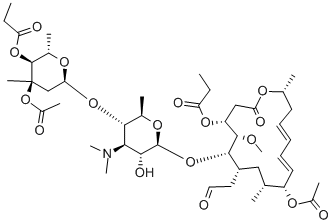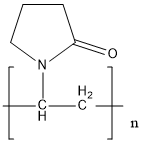Midecamycin Acetate
- CAS NO.:55881-07-7
- Empirical Formula: C45H71NO17
- Molecular Weight: 898.046
- MDL number: MFCD00869591
- EINECS: 2598796
- SAFETY DATA SHEET (SDS)
- Update Date: 2022-12-21 16:56:50

What is Midecamycin Acetate?
Description
Miokamycin (midecamycin acetate) is a macrolide antibiotic useful in the treatment of respiratory tract, dermatological and surgical infections due to grampositive bacteria and mycoplasmas.
Originator
Meiji Seika (Japan)
brand name
MIOCAMYCIN
Pharmaceutical Applications
A semisynthetic diacetyl derivative of midecamycin A1. It is generally less active than erythromycin and some strains of H. influenzae and E. faecalis are resistant. It is rapidly and extensively metabolized, though some metabolites retain antibacterial activity.
Absorption of the dry formulation is unaffected by food, whereas that of the oral suspension is delayed. In various studies the peak plasma concentration was 1.65, 1.31–3 and 1.3–2.7 mg/L after doses of 400, 600 and 800 mg, respectively.
It is said to exhibit less toxicity than earlier macrolides. Attention has been paid to its interaction with theophylline, which resembles that of other macrolides. It is of limited availability.
Properties of Midecamycin Acetate
| Melting point: | ~220° (with coloration) |
| Boiling point: | 878.7±65.0 °C(Predicted) |
| alpha | D25 -53° (c = 1.0 in chloroform); D20 -74° (c = 1 in methanol) |
| Density | 1.20±0.1 g/cm3(Predicted) |
| pka | 13.06±0.70(Predicted) |
Safety information for Midecamycin Acetate
Computed Descriptors for Midecamycin Acetate
New Products
4-AMINO-TETRAHYDRO-PYRAN-4-CARBOXYLIC ACID HCL 4-(Dimethylamino)tetrahydro-2H-pyran-4-carbonitrile 4-Aminotetrahydropyran-4-carbonitrile Hydrochloride (R)-3-Aminobutanenitrile Hydrochloride 3-((Dimethylamino)methyl)-5-methylhexan-2-one oxalate 1,4-Dioxa-8-azaspiro[4.5]decane 5-Bromo-2-nitropyridine Nimesulide BP Aceclofenac IP/BP/EP Diclofenac Sodium IP/BP/EP/USP Mefenamic Acid IP/BP/EP/USP Ornidazole IP Diclofenac Potassium THOMAIND PAPER PH 2.0 TO 4.5 1 BOX BUFFER CAPSULE PH 9.2 - 10 CAP SODIUM CHLORIDE 0.1N CVS ALLOXAN MONOHYDRATE 98% PLATINUM 0.5% ON 3 MM ALUMINA PELLETS (TYPE 73) LITHIUM AAS SOLUTION 2-Bromo-1-(bromomethyl)-3-chloro-5-nitrobenzene 2-Bromo-3-nitroaniline N-(3-Hydroxypropyl)-N-methylacetamide 3-Bromo-6-chloropyridazine 4-ethyl-3-nitrobenzoic acidRelated products of tetrahydrofuran






You may like
-
 1-Methyl-6-oxo-1,6-dihydropyridazine-3-carbonitrile 98%View Details
1-Methyl-6-oxo-1,6-dihydropyridazine-3-carbonitrile 98%View Details
99903-60-3 -
 88491-46-7 98%View Details
88491-46-7 98%View Details
88491-46-7 -
 1823368-42-8 98%View Details
1823368-42-8 98%View Details
1823368-42-8 -
 2-(3-(tert-butyl)phenoxy)-2-methylpropanoic acid 1307449-08-6 98%View Details
2-(3-(tert-butyl)phenoxy)-2-methylpropanoic acid 1307449-08-6 98%View Details
1307449-08-6 -
 Ethyl 3-(furan-2-yl)-3-hydroxypropanoate 25408-95-1 98%View Details
Ethyl 3-(furan-2-yl)-3-hydroxypropanoate 25408-95-1 98%View Details
25408-95-1 -
 2-Chloro-5-fluoro-1-methoxy-3-methylbenzene 98%View Details
2-Chloro-5-fluoro-1-methoxy-3-methylbenzene 98%View Details
1805639-70-6 -
 1784294-80-9 98%View Details
1784294-80-9 98%View Details
1784294-80-9 -
 Lithium ClavulanateView Details
Lithium ClavulanateView Details
61177-44-4